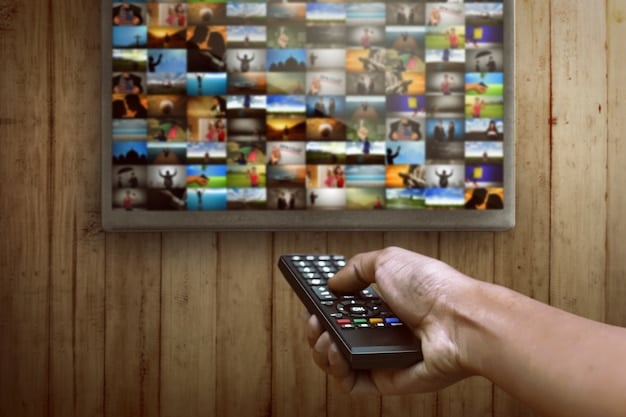Cord-Cutting Guide: Save $75 Monthly on Streaming Services

Cord-cutting involves canceling your cable subscription and switching to streaming services, potentially saving you an average of $75 per month while still enjoying a wide variety of content.
Are you tired of high cable bills and limited channel options? The cord-cutting guide: ditch cable and save $75 monthly with streaming services is your roadmap to a more affordable and flexible entertainment experience. Let’s explore how you can break free from cable contracts and embrace the world of streaming.
Understanding Cord-Cutting and Its Benefits
Cord-cutting is more than just a trend; it’s a smart financial move that empowers you to choose your entertainment. By understanding the basics and benefits, you can make an informed decision to cut the cord.
What is Cord-Cutting?
Cord-cutting refers to the practice of canceling your cable television subscription in favor of streaming services. Instead of relying on a traditional cable box, you use internet-based platforms to watch your favorite shows, movies, and live events.
This shift allows you to customize your viewing experience, paying only for the content you want rather than bundled packages that include channels you never watch.
Why People Are Ditching Cable
Several factors drive the cord-cutting phenomenon. Cost is a primary motivator, as cable bills often exceed $100 per month. Streaming services offer a more budget-friendly alternative, with many costing less than $20 each.
Flexibility is another key benefit. Streaming services allow you to watch content on multiple devices, anytime and anywhere. Plus, many offer on-demand libraries, giving you access to a vast selection of shows and movies.
- Cost Savings: Reduce your monthly expenses by switching to more affordable streaming options.
- Flexibility: Watch your favorite content on any device, at any time.
- Customization: Choose the streaming services that match your interests and viewing habits.
- On-Demand Content: Access a vast library of shows and movies whenever you want.

In summary, cord-cutting offers a compelling combination of cost savings, flexibility, and customization, making it an attractive option for anyone looking to simplify their entertainment and reduce their monthly bills.
Choosing the Right Streaming Services
Selecting the right streaming services is crucial to a successful cord-cutting transition. Consider your viewing habits and preferences to build a package that meets your needs.
Identifying Your Viewing Needs
Start by listing the types of content you enjoy watching. Do you primarily watch live sports, news, movies, or TV shows? Understanding your preferences will help you narrow down your options.
Also, consider the number of users in your household. Some streaming services offer multiple simultaneous streams, which can be essential for families with different viewing habits.
Popular Streaming Options
Several streaming services cater to different needs and budgets. Netflix and Hulu are popular choices for on-demand TV shows and movies. For live TV, consider services like Sling TV, YouTube TV, or FuboTV.
Specialty services like Disney+ and ESPN+ offer niche content for families and sports enthusiasts. By combining different services, you can replicate your cable package at a fraction of the cost.
- Netflix: Offers a wide range of TV shows, movies, and original content.
- Hulu: Provides access to current TV episodes, movies, and live TV options.
- Sling TV: A budget-friendly live TV streaming service with customizable channel packages.
- YouTube TV: Offers a comprehensive live TV experience with unlimited DVR storage.
Choosing the right streaming services involves assessing your viewing needs and exploring the available options. By carefully selecting services that align with your preferences, you can create a tailored entertainment package that suits your budget and lifestyle.
Essential Equipment for Cord-Cutting
To fully enjoy the benefits of cord-cutting, you’ll need the right equipment. From streaming devices to antennas, here’s what you should consider.
Streaming Devices
A streaming device is essential for accessing streaming services on your TV. Popular options include Roku, Amazon Fire TV, Apple TV, and Chromecast. These devices connect to your TV via HDMI and provide access to a variety of streaming apps.
Consider factors like ease of use, app availability, and compatibility with your TV when choosing a streaming device. Some smart TVs also have built-in streaming capabilities, eliminating the need for an external device.
Antennas for Local Channels
An Over-the-Air (OTA) antenna allows you to access local broadcast channels for free. This is a great way to watch local news, sports, and network programming without a cable subscription.
The range and type of antenna you need will depend on your location and the distance to broadcast towers. An amplifier can improve signal strength in areas with weak reception.
- Roku: A user-friendly streaming device with a vast app selection.
- Amazon Fire TV: Offers seamless integration with Amazon services and Alexa voice control.
- Apple TV: Provides a premium streaming experience with access to Apple’s ecosystem.
- OTA Antenna: Allows you to access local channels for free.

Investing in the right equipment is crucial for a seamless cord-cutting experience. A reliable streaming device and an OTA antenna can provide access to a wide range of content, ensuring you don’t miss your favorite shows and local broadcasts.
Setting Up Your Streaming Services
Once you’ve chosen your streaming services and equipment, it’s time to set everything up. This process is generally straightforward, but here are some tips to ensure a smooth transition.
Connecting Your Streaming Device
Connect your streaming device to your TV via HDMI. Power on the device and follow the on-screen instructions to connect to your Wi-Fi network. Once connected, you can download and install the streaming apps of your choice.
Create accounts for each streaming service and log in to the apps on your streaming device. Some services offer free trials, allowing you to test their content and features before committing to a subscription.
Installing and Configuring an OTA Antenna
Connect your OTA antenna to your TV’s antenna input. Scan for channels using your TV’s settings menu. The number of channels you receive will depend on your location and antenna placement.
Experiment with different antenna positions to optimize signal strength. A window or rooftop location often provides the best reception. Consider using an amplifier if you’re having trouble receiving a strong signal.
- HDMI Connection: Connect your streaming device to your TV using an HDMI cable.
- Wi-Fi Setup: Connect your streaming device to your home Wi-Fi network.
- App Installation: Download and install streaming apps on your device.
- Channel Scanning: Scan for local channels after connecting your OTA antenna.
Setting up your streaming services involves connecting your device, installing apps, and scanning for local channels. With a little patience and effort, you can create a customized entertainment system that suits your needs and budget.
Managing Your Streaming Subscriptions
To maximize your savings with cord-cutting, it’s essential to manage your streaming subscriptions effectively. This includes tracking your expenses, canceling services you no longer use, and taking advantage of deals and promotions.
Tracking Your Streaming Expenses
Create a spreadsheet or use a budgeting app to track your monthly streaming expenses. This will help you identify areas where you can cut back and ensure you’re not overspending on unnecessary services.
Review your subscriptions regularly and cancel any services you no longer use. Many streaming services offer flexible month-to-month subscriptions, making it easy to cancel or pause your service when needed.
Leveraging Deals and Promotions
Take advantage of free trials, discounts, and bundled offers to save money on streaming services. Many providers offer promotional rates for new subscribers or discounts for bundling multiple services.
Consider sharing subscriptions with family members or friends to split the cost. Many streaming services allow multiple users to watch simultaneously, making this a cost-effective option.
- Expense Tracking: Monitor your monthly streaming expenses to stay within budget.
- Subscription Review: Regularly review and cancel unused subscriptions.
- Promotional Offers: Take advantage of free trials, discounts, and bundled offers.
- Subscription Sharing: Share subscriptions with family members or friends to split the cost.
Effectively managing your streaming subscriptions is crucial for maximizing your savings. By tracking your expenses, canceling unused services, and leveraging deals and promotions, you can enjoy a wide range of content without breaking the bank.
Troubleshooting Common Cord-Cutting Issues
While cord-cutting offers many benefits, you may encounter some technical issues. Here are some common problems and how to resolve them.
Buffering and Streaming Quality
Buffering and poor streaming quality can be frustrating. Ensure you have a stable and fast internet connection. A wired connection (Ethernet) is often more reliable than Wi-Fi.
Adjust the streaming quality settings in your streaming app. Lowering the resolution can reduce buffering and improve performance, especially on slower internet connections.
Connectivity Problems
If you’re experiencing connectivity problems, restart your streaming device, modem, and router. Check your Wi-Fi password and ensure you’re connected to the correct network.
Move your router to a central location in your home to improve Wi-Fi coverage. Consider upgrading your router or internet plan if you consistently experience connectivity issues.
- Internet Speed: Ensure you have a stable and fast internet connection.
- Streaming Quality Settings: Adjust the streaming quality to reduce buffering.
- Device Restart: Restart your streaming device, modem, and router to resolve connectivity issues.
- Router Placement: Move your router to a central location for better Wi-Fi coverage.
Troubleshooting common cord-cutting issues involves addressing buffering, streaming quality, and connectivity problems. By following these tips, you can ensure a smooth and enjoyable streaming experience.
| Key Point | Brief Description |
|---|---|
| 💰 Saving Money | Cut cable, save an average of $75 monthly. |
| 📺 Choose Services | Pick streaming to match viewing preferences. |
| 📡 Use an Antenna | Add antenna for local channels for free. |
| 🌐Manage Subscriptions | Cancel or pause, to manage your expenses. |
Frequently Asked Questions (FAQ)
▼
Cord-cutting involves canceling your cable subscription and using streaming services for TV. You can watch on devices like Roku, Apple TV, or smart TVs through internet.
▼
Savings vary, but many people save $50-$100+ monthly by switching to streaming. This depends on what services are needed and price comparison between streaming and cable.
▼
You’ll need a stable internet connection, a streaming device (like Roku or Apple TV), and optionally an OTA antenna for local channels. A smart TV might work too.
▼
Yes! Services like YouTube TV, Sling TV, and FuboTV are designed for live TV, which includes Sports, and News. An OTA antenna is helpful for all local broadcasting.
▼
Use a spreadsheet or budgeting app to track costs. It is important to review regularly, cancel unused services, and take advantage of trials and deals for potential subscription share.
Conclusion
Cutting the cord empowers you to take control of your entertainment, save money, and enjoy the shows, movies, and live events you love. By understanding your options, setting up your equipment, and managing your subscriptions, you can create a customized streaming experience that fits your needs and budget.





